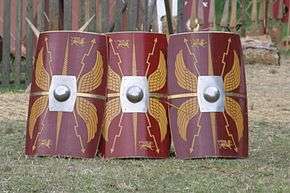Legatus
 |
|---|
| This article is part of a series on the politics and government of ancient Rome |
| Periods |
|
| Roman Constitution |
| Ordinary magistrates |
| Extraordinary magistrates |
| Titles and honours |
| Precedent and law |
|
|
| Assemblies |
A legatus (anglicized as legate) was a high ranking Roman military officer in the Roman Army, equivalent to a modern high ranking general officer. Initially used to delegate power, the term became formalized under Augustus as the officer in command of a legion.
From the times of the Roman Republic, legates had received large shares of the militaries rewards at the end of a successful campaign, which made the position a lucrative one, so it could often attract even distinguished consuls or other high ranking political figures within Roman Politics (e.g., the consul Lucius Julius Caesar volunteered late in the Gallic Wars as a legate under his first cousin once removed, Gaius Julius Caesar).
Overview
A Legatus held full power of his legion; Consul Militaris held control of all legions under the Emperor who held entire control of Rome during the time of Roman Empire. After the Roman Republic, all control from the Senate shifted to the Emperor, making him the most powerful person in Rome. The Legatus Legionis would delegate duties to his command staff, which then would carry out his tasks. The Legatus is the most respected military officer in Rome.
The men who filled the office of legate were drawn from among the senatorial class of Rome. There were two main positions; the legatus legionis was an ex-praetor given command of one of Rome's elite legions,[1] while the legatus pro praetore was an ex-consul, who was given the governorship of a Roman province with the magisterial powers of a praetor, which in some cases gave him command of four or more legions. A legatus was entitled to twelve lictors who carried out punishments with fasces (bundled rods).
By the time of the Roman Republic, the term legatus was applied to those holding delegated authority (usually a consul or proconsul). Julius Caesar made wide use of the title throughout the Gallic Wars.[2]
From Augustus, the emperor gave the title of legatus legionis to senior commanders (former military tribunes) of a legion, except in Egypt and Mesopotamia, where the legions were commanded by a praefectus legionis of an equestrian rank. The legatus legionis was under the supreme command of Legatus Augusti pro praetore of senatorial rank. If the province was defended by a single legion, the Legatus Augusti pro praetor was also in direct command of the legion.This post was generally appointed by the emperor. The person chosen for this rank was a former tribune, and although the emperor Augustus set a maximum term of command of two years for a legatus, subsequent emperors extended the tenure to three or four years, although he could serve for a much longer period. In a province with only one legion, the legatus served as the provincial governor, but in provinces with multiple legions, each legion had a legatus and a separate provincial governor had overall command.
The legatus could be distinguished in the field by his elaborate helmet and body armour, as well as his scarlet paludamentum and cincticulus. The latter was a scarlet waist-band tied around his waist in a bow.
A legatus legionis could order capital punishment.[3]
The senatorial legatus legionis was removed from the Roman army by Gallienus, who preferred to entrust the command of a legionary unit to a leader chosen from within the equestrian order who had a long military career.
Diplomatic legatus
Legatus was also a term for an ambassador of the Roman Republic who was appointed by the senate for a mission (legatio) to a foreign nation, as well as for ambassadors who came to Rome from other countries.[4] This is the sense of the word that survives in the phrase Papal legate.
See also

- List of Roman army unit types
References
- ↑ "The Roman Army". Accessed April 16, 2007.
- ↑ Smith (1901) Dictionary of Greek and Roman Antiquities Vol. 1 PA797. Books.google.com. 2006-07-14. Retrieved 2011-04-16.
- ↑ Smith (1901) Dictionary of Greek and Roman Antiquities Vol. 1 PA811. Books.google.com. 2006-07-14. Retrieved 2011-04-16.
- ↑ Smith, Dictionary of Greek and Roman Antiquities (1875), Bill Thayer's edition, entry on "Legatus".